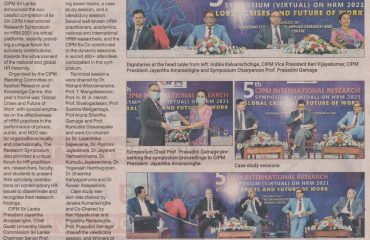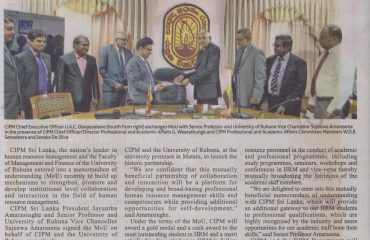(An article published on BMD magazine)
CIPM Sri Lanka is a professional body and the Nation’s leader in Human Resource Management which has been established by an Act of Parliament to deliver key objectives and values in the area of people management to this country. Excerpts of an interview with newly elected President of CIPM Sri Lanka discusses CIPM’s role in the Country’s forward journey in terms of a National HR development plan.
Q1. What is Chartered Institute of Personnel Management (CIPM) and its role?
We are a member driven organization with over 1600 professional members who hold people management leadership positions including higher level positions in driving business in private and public sector institutions. Recently it was recognized and established by the Parliament Act No. 31 of 2018 as Chartered Institute of Personnel Management (CIPM) Sri Lanka giving effect to the prestigious Charter status that we received as a professional people management body.
CIPM is a member of the Asia Pacific Federation of Human Resource Management (APFHRM) and and is affiliated to theWorld Federation of People Management Associations (WFPMA) which are- the two leading professional bodies in the region and the world respectively for the practice of HRM. Our professional Business School having a student base of around 9000, produces over 1000 qualified HR professionals annually. Our Chartered Qualification in HRM (CQHRM), which is recognized regionally, is considered the de-facto standard for HR professionals.
Working through our membership other stakeholders and business professionals, we aim to promote and foster best practices in HRM so that companies and institutions are able to achieve their strategic objectives elevating them to the next level of efficiency and growth. We advocate the use of disruptive technologies to further our objectives.
Q2. As the newly elected President of CIPM, what are your main plans and objectives in the current context .
As a Chartered professional body in HR with access to a significant pool of resources, one of our main objectives is to play a national role by engaging directly with policy makers to share this rich composite/fusion of experience in order to draw up an efficient and effective National HR Development Plan which will enable the nation to be the regional business hub by ensuring the availability of an appropriately skilled, qualified labor force in the required numbers while fulfilling the aspirations of youth.
Q3. Why do you think that there is a need for a better structured National HR Development Plan?
I believe that there is a flaw in our education system right now as we lack the ability to produce the right people in the right numbers with the right qualifications and attitudes to fulfill our national requirements. Our students follow their own and their parent’s advice when selecting their areas of education without giving heed to their own abilities, talents and aspirations, the need for those particular skills and aptitudes in the market etc which leads to a dysfunctional labor force resulting in disengagement from national, personal aspirations priorities, and social upheaval.
Furthermore, the identification and assessment of development needs in terms of skills and attitudes need to be done early at the school level exit points so that we can coordinate and plan for the timely availability of required resources such as trainers, training infrastructure and facilities.
The National HR Development Plan will identify the requirements of the national labor force to achieve Sri Lanka’s aspirations to be a regional hub in the world economy.
Q4. What are your thoughts on our education system? Does it need revamping/restructuring?
Our education system currently has two main ‘ Exit Points’ – the GCE Ordinary Level and Advanced Level. While approximately 600,000 students sit for the OLs, approximately 360,000 students sat for the ALs this year and I believe out of this number may be around 200,000 will qualify to enter national universities with only around 41,000 gaining admission. What happens to the 240,000 who do not qualify at the OLs and around 320,000 who do not gain admission to universities? Do we know who they are, their aspirations, skills, abilities, attitudes, and aptitudes? Some of the students who do gain admission to the universities, will they be employable, or will they be a burden on the country? Do they have the required skill sets and attitudes when they reach the job market? Are professional counselling facilities available at each exit point to help students understand their abilities and prospects rather than basing their future on whim and fancy?
When reviewing the available facilities for skills development (currently 1300 vocational training centers/professional bodies including private sector institutions) to accommodate the above 600,000 students who are being released by approximately 10,000 schools in the country, it has become a real challenge and it is of paramount importance for us to analyze the issues and these gaps in terms of skills development when releasing youth to the society at two Exit points with no directions on employment opportunities.
Q5. What are the areas that CIPM can plan to execute in collaboration with the Government?
CIPM is established in terms of resources and expertise to collaborate with and support the Government in developing an integrated Strategic National HR Development Plan considering the needs of the private and state sectors, is the execution of the plan to build a national labor force comprising of the required numbers with the rights skills, attitudes, aptitudes, qualifications to fulfill our national aspirations.

Q6. Do you have any proposals, from CIPM to the Government in terms of shifting the effectiveness of overall administration to the next level?
We are keen to engage with the Government to assess and fulfill their short/medium term plans by developing a comprehensive workforce and skills development approach for grooming youth to the job market or self-employment, and assessment for performance improvement. There are challenges in the country in the areas of performance management, leadership development and driving for excellence mainly in the public sector.
In order to establish a performance driven/accountability driven Culture in the Government and public sectors, it is imperative that a transparent performance management system driven by Key Performance Indicators (KPIs) and regular performance appraisals coupled to a rewards system is implemented.
Our resource pool of professionals is prepared to partner in the execution process by providing training through workshops and seminars which will help in closing any systems or competency gaps to shift the effectiveness and efficiency of the overall administration to the next level. Key amongst these initiatives would be structured programmes specifically designed for leadership development and instilling a high level of confidence in the public sector workforce.
Q7. Are there any projects that CIPM is planning to embark at national level in coming months to analyze issues in the national labour force?
We have commissioned three applied research studies into areas which have a major impact on our economy and society. The first applied research study is to ascertain why our farmers, who play an extremely important role in the economy, have not evolved into being recognized as professionals in contrast to their counterparts in developed countries.
The agriculture sector which plays a pivotal role in the economy has been witnessing a trend of continuous decline in terms of numbers employed since 1998 (source: www.data.worldbank.org). When food and agricultural produce is a key concern in the world economy, are we as a nation letting go of an area which has great potential in terms of agricultural exports. The insights we hope to gain from this study will help us to initiate a public discussion in order to work together with the relevant authorities to design a time bound national programme to develop the agricultural sector.
The second is to understand why the members in the construction trade such as plumbers, masons, carpenters, electricians etc do not enjoy the same professional acceptance in the society.
The third is to ascertain the reasons why our female workers leave their families and jobs to be employed in low level occupations such as housemaids in the Middle East knowing very well that they will most likely be victimized while earning only a minimally higher wage. The faster we understand the underlying causes, we will be in a better position to provide meaningful solutions which has the potential to impact many important areas from a national perspective including direct impacts on family and society at large.
I propose that there is a critical need for Professional education to be strengthened in the country.
Youth education mainly in professional education and their skills development need to be spearheaded with public and private partnership, however government has to facilitate and enable the required opportunities and encourage private professional bodies to come forward and take challenges of developing, grooming and certifying the youth for the labour force in the country and deploy talents in various positions in the job market. The current government’s intervention in this whole process is absolutely not sufficient to manage this national requirement.
I propose that there is a need for strengthening vocational training centers in the country
We need more vocational training centers for our country to develop skills of youth. Upon completion of OLs and ALs, students are being released to the society and they are the future human resources in our national labor force, their skills development are required to be done according to a national man power plan, based on the need and the economic direction in the country. Developing the right skills according to a national action plan focusing on the need of specific skillsets, will help the labor force to be more efficient and effective in contributing to achieve aspirations. A precise skill set in the right numbers would no doubt have a positive impact on the GDP of the country.
Workforce distribution, deployment of talent and labour market reconciliation are highly essential elements to be addressed and these must be in the priority list in delivering to support the GDP.
Sri Lankan youth need to be directed for vocational training/professional education depending on the labour/skill demands and the composition/ratio could be decided by the relevant authority/sector proportionately ensuring logical workforce distribution/deployment in responding to the demand and supply in the market for each field of vocation/profession/career with the direct association to the GDP
I propose setting up Career Guidance centers island wide.
Immediate interventions are required to establish career guidance centers in the country covering all schools, and also to train batches of selected teachers to guide students to choose and develop their skills while selecting professions based on their interests and own talents. At the career guidance hubs, students will be educated about the job market, job roles/positions and employer demands, self-employment opportunities, entrepreneurships etc. I strongly believe that there is a need in the country to introduce a system where every student should attend or cover a session of career guidance as a compulsory requirement before they leave school at the end of their secondary education.





